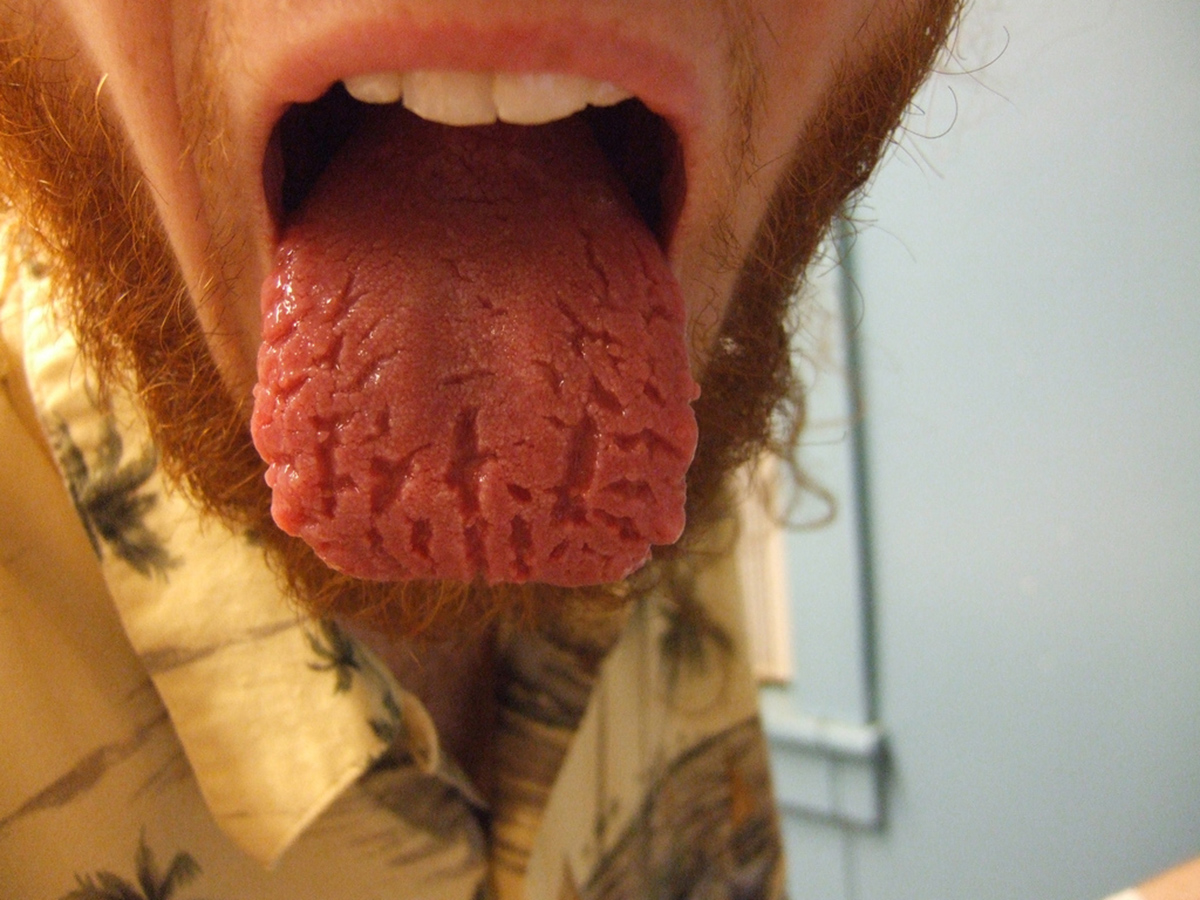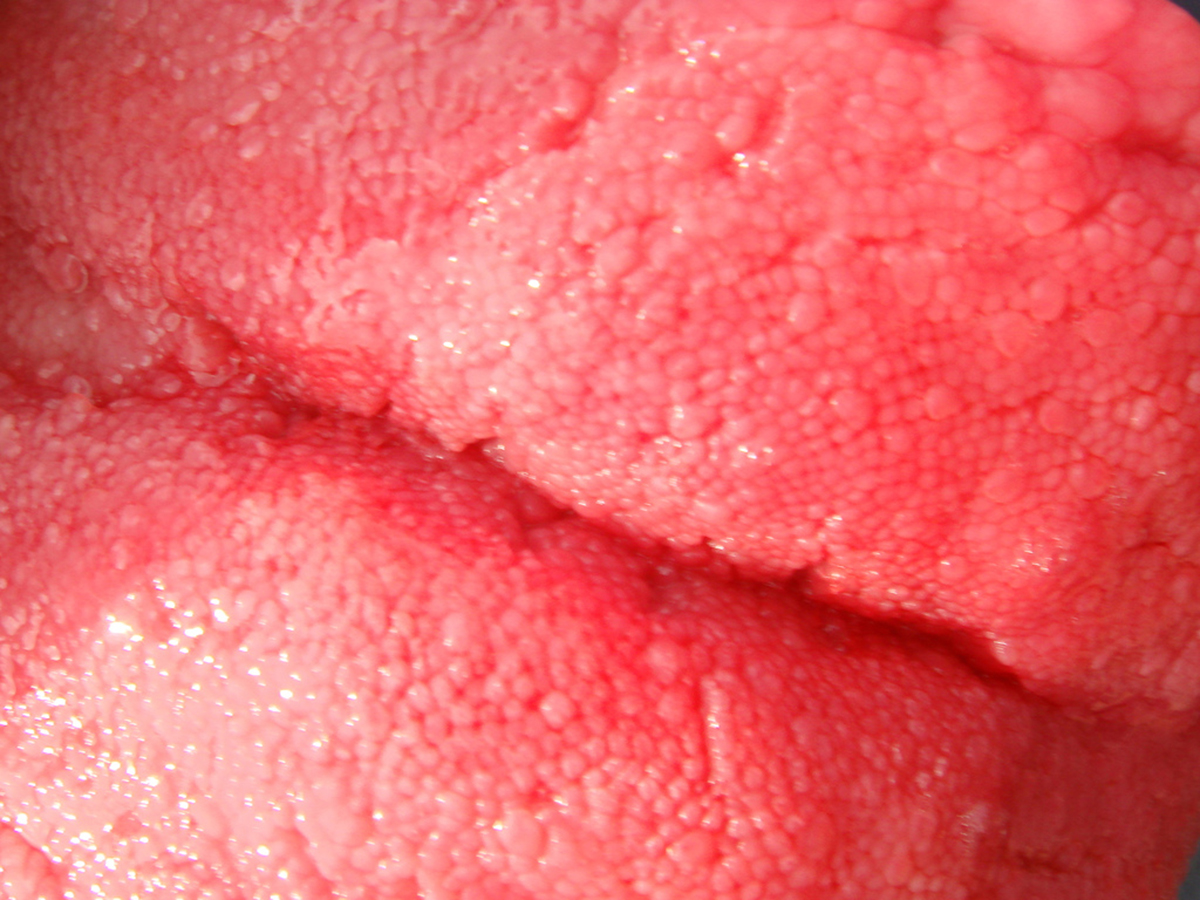Oh yes, the tongue can tell secrets about your health. Your tongue is a strong muscular organ that is normally covered with mucosa, a pink, moist surface. If you look closely you will see tiny bumps (papillae), which seem to make the tongue rough in texture. The papillae are covered with thousands of taste buds, which are cells that connect to the nerves leading to your brain. Aside from giving you a sense of taste, your tongue plays an important role in allowing you to speak, chew, and swallow food.

Bright Red Tongue
The tongue has a natural pink color because it is rich in tiny blood vessels. However, when it is persistently bright red, beefy or strawberry-like, you may be suffering from a nutritional deficiency. A lack of vitamin B12 or iron may cause a loss of papillae, which makes the tongue appear smooth and glossy. Balding of the tongue can lead to pain when you eat hot or spicy foods.
This condition is common among vegetarians, since they are prone to have low levels of vitamin B12, a nutrient found in meats. If you are a vegetarian and you notice your tongue is strawberry red in color, consult your doctor about taking health supplements. Vitamin deficiencies are also associated with problems in absorption in the gastrointestinal tract, so seek medical advice if you have a bright red tongue.
Black Hairy Tongue
The tongue is covered with papillae that can grow long and look “hairy.” These can become dark and worn out, but experts agree that is not a serious problem. It may be caused by poor oral hygiene, smoking, medications eating a soft diet, and a dry mouth. Overgrown papillae are more likely to become discolored by food and harbor bacteria. All you need to do is to avoid smoking or any offending cause, brush your tongue or use a tongue scraper, and practice good oral hygiene.
Read More: The Truth About Black Hairy Tongue: One Scary Health Condition You Really Don't Want
Cottage Cheese Tongue
If your tongue looks lumpy with white patches that look like cottage cheese, you may have yeast infection caused by overgrowth of Candida. Also called oral thrush, this condition is often linked to overuse of antibiotics. The moth normally harbors yeast and bacteria, but when you take antibiotics, bacteria may be killed and allow yeast to grow uncontrolled. Thrush can also occur in people with weakened immune systems, in young children, in people with autoimmune disease or uncontrolled diabetes, in the elderly, and in chemotherapy patients. If you think you may have thrush, consult your doctor. It may cause a bit of pain and taste disturbances and cannot be treated with over-the-counter products.
What Your Tongue Reveals About Your Health
Cracked Tongue
Cracks and fissures may appear in your tongue as you grow older. These are normally harmless, but problems may occur if you have poor oral hygiene, which may lead to infection, such as a fungal infection of the crevices. You may suddenly experience pain, sometimes burning sensation, and a foul breath. The infection may be treated with topical antifungal medications. Sometimes dentures and other dental appliances can also cause indentations on your tongue. To avoid having a cracked tongue, drink enough water, practice oral hygiene, and make sure you have properly fitting dental fixtures.

White Patches On The Tongue
If you have white patches on the tongue that cannot be scraped off, you may have what is known as leukoplakia, which may have different causes. One is chronic irritation due to smoking. Smoking cessation usually leads to improvement. White patches on the sides of the tongue may be due to irritation of the tongue from rubbing the sides of the lower teeth. Overgrowth of cells in the tongue due to inflammation may be caused by oral lichen planus, an autoimmune condition. It produces a a white lace-like pattern on the tongue, but sometimes an erosive form can develop, which looks like shallow ulcerations.
Persistent Red Patches
Red patches on the tongue that do not go away with treatment may be a sign of tongue cancer. Unlike canker sores, these red lesions do not resolve within two weeks. Consult your doctor if you have persistent red patches on the tongue.
Geographic Tongue
This refers to a tongue that looks like a bumpy (geographic) terrain. The most common tongue condition, geographic tongue affects about 14 percent of the population. It may affect different areas of your tongue and can increase your sensitivity to acidic or spicy foods. It is typically harmless, and although the cause is not clear, it could be due to random shrinking of the taste buds. Geographic tongues usually need no treatment, but if you experience pain, you may see a doctor who may prescribe an anti-inflammatory paste or antihistamine rinse.
Swollen Tongue
Your tongue can suddenly swell and become enlarged. One of the most common causes is allergies to food or medications, or even a bee sting. This can become a life-threatening situation, especially if it is associated with difficulty in breathing, swallowing, and fainting. You must seek emergency care if this occurs.
See Also: Pros and Cons of Tongue Piercing
Other causes of tongue swelling include side effects of medications such as ACE inhibitors, which are used to treat high blood pressure and nonsteroidal anti-inflammatory drugs (NSAIDs) such as Aspirin, Aleve, and Advil. Tongue injury due to biting or eating/drinking hot foods can also cause tongue inflammation and swelling. Other causes of inflammation that leads to swollen tongue include oral thrush and oral herpes. Other medical conditions that cause tongue enlargement (macroglossia) include tongue cancer, acromegaly, sarcoidosis, amyloidosis, Kawasaki disease, Down syndrome and hypothyroidism. Consult your doctor if you have a swollen or enlarged tongue.
Tongue Growths
New growths on the tongue may be harmless, such as raised, thickened nodules that may be due to traumatic fibroma. However, they can also be a sign of cancer, such as squamous cell carcinoma, which is the most common cancer of the oral cavity. It usually affects the side of the tongue and commonly involves older people. Risk factors include tobacco smoking, alcohol use, and infection with human papillomavirus (HPV).
Ulcerations and nodules may be seen as the tumor progresses. Sometimes the tumor involves the base of the tongue and is undetected until the late stage of development. See your doctor if you have an unusual new growth on your tongue.
- MedicieNet. Tongue Problems. http://www.medicinenet.com/tongue_problems/article.htm
- Readers’ Digest. 9 Surprising Secrets Your Tongue Can Reveal About Your Health. http://www.rd.com/slideshows/tongue-disease-signs/
- DailyMail. How the colour of your tongue reveals your health. http://www.dailymail.co.uk/health/article-37340/How-colour-tongue-reveals-health.htmlPhoto courtesy of Mike Burns via Flickr: www.flickr.com/photos/mike-burns/1155987283
- Photo courtesy of MrVJTod via Flickr: www.flickr.com/photos/mrvjtod/169803547
- www.medicinenet.com
- www.rd.com
- /www.dailymail.co.uk

